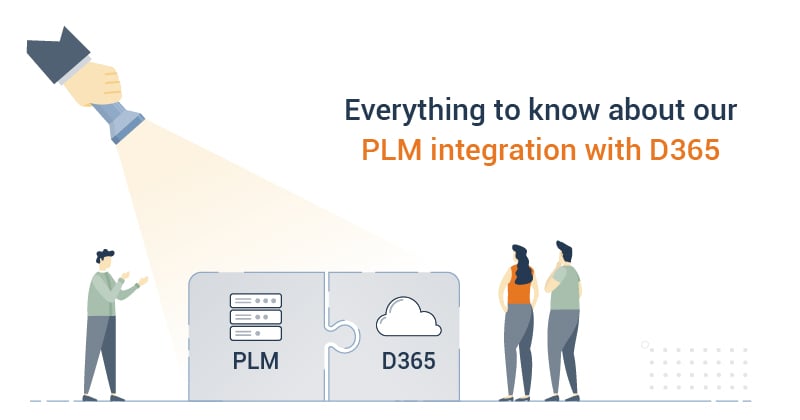As a Microsoft ISV offering software solutions for over 18 years, we have often been asked: What do I need to know about To-Increase's PLM integration with Dynamics 365?
Here's a blog sharing everything you need to know about our PLM integration solution for Dynamics 365 Finance and Supply Chain Management (F&SCM). You'll find a compilation of various aspects of our integration solution and can read each topic in depth using the links provided.
Overview of To-Increase's PLM integration with Dynamics 365
Our PLM-ERP integration solution connects third-party PLM, PDM, or CAD systems with Microsoft Dynamics 365 F&SCM.
The PLM integration solution is fully embedded in Dynamics 365 and follows the Dynamics 365 business logic, allowing seamless integration.
We offer out-of-the-box PLM-ERP integrations for Siemens Teamcenter and PTC Windchill. You can adapt our PLM integration framework for any other PLM, PDM, or CAD system based on your business requirements.
Some examples of PLM systems for which the integration can be configured include 3DX Dassault, Oracle Agile, Ansys, and Vault.
Our integration solution leverages specific capabilities of Engineering Change Management (ECM), a module within Dynamics 365 to handle product data better; therefore, ECM is a prerequisite to the solution.
Let's go through a few articles, each highlighting unique information about our solution.
Features of our PLM-ERP integration in Dynamics 365
One of the primary actions a business takes when analyzing whether the solution is a right fit is to check the features of the solution. Not knowing what to look for in an integration solution can cost you as you won't have the complete picture of how to address your business needs.
Some of the features you can expect from our PLM integration with Dynamics 365 are:
- Automated and structured transfer of product data, bill of materials (BOMs), and engineering information
- Data validation before posting into Dynamics 365 ERP through a staging journal
- Access logistical data from Dynamics 365 in the PLM with 'product logistics insights' via web services
- Manage version updates throughout the product's lifecycle and carry out local change orders
Get to know the remaining features here: Key Features of To-Increase's PLM Integration Solution for Dynamics 365 ERP
Benefits of using our PLM integration with Dynamics 365
Our integration solution breaks the silos between your PLM and Dynamics 365, making it highly beneficial for your business.
The top benefits of using our PLM-ERP integration solution include the following:
- The solution is certified for Microsoft Dynamics, leverages Dynamics 365 capabilities, and follows Microsoft's upgrade policy, reducing maintenance hassles.
- There is one quick overview and end-to-end visibility of all product data and product-related processes in a single digital location.
- The solution is intuitive, user-friendly, and configurable to map PLM data using various formats.
- Automate and structure the data import and product release processes by setting up defaults in the template setup of the ECM Product release policies, reducing time and cost.
Check out this blog to learn about all the 12 benefits: PLM Integration for Dynamics 365: The Top Benefits We Offer
How our solution is preconfigured to ease usability
Our solution is simple, ready to use, and can adapt to your business needs with minimum configuration.
A few processes preconfigured in our PLM-ERP integration solution are:
- Transferring product data from PLM to ERP as it leverages the batch server process in Dynamics 365
- Managing product releases with ECM and customizing the amount of data to be released
- Messaging and mapping of product data using two flow types (to create products or engineering change orders)
- Tracking product versions and changes to have better control over costs and schedules
Get in-depth information on how our PLM integration is preconfigured here: Preconfigured PLM Integration with Dynamics 365: Quick Value for Manufacturers
How our PLM integration solution works
The integration supports data movement for enterprises having one, two, or multiple legal entities. For two legal entities, the data movement process from PLM/CAD to the manufacturing plant occurs in two phases:
1. Data movement from PLM or CAD to the engineering company (working as a product master data management system) with PLM integration
2. Data movement from the engineering company to the manufacturing plant with ECM
To know how the data transfer occurs from PLM to ERP, click here: How Data Moves from PLM to Dynamics 365 with our Integration
The implementation process of our PLM-ERP integration
The software implementation begins after the necessary assessments and proof-of-concept. We follow a well-defined implementation process that can be completed in under 2 to 3 weeks or less, depending on your PLM system.
The 5 steps to implementing our solution are:
1. Analysis phase: Thoroughly analyze the data to be transferred from the PLM to Dynamics 365.
2. Design phase: Create initial designs to import the defined data from PLM to ERP based on the requirements.
3. Configuration phase: Analyze files, map data to the staging journal, and configure finer details in the user interface.
4. Deployment phase: Functioning integration undergoes a data quality check and user acceptance testing (UAT) support.
5. Operation phase: It's the point of go-live where additional support, such as hypercare, training, and monitoring, is done.
To understand the implementation process in greater detail, view this: Implementation Process of To-Increase's PLM Integration with Dynamics 365
The unique value our solution can deliver to your business
Among the sea of integration solutions, you must know whether you are getting the best value for your investment.
Some of the exclusive values we can offer you are:
- Maximize data sharing while retaining true data ownership
- Deep industry knowledge with a dedicated focus on Dynamics 365
- Ensure integration data quality with data readiness checks using ECM
- Easy scalability beyond the PLM-ERP integration with our solution portfolio
Read this blog detailing the topic above: Why Should You Choose To-Increase's PLM Integration with Dynamics 365
Cost of our PLM integration with Dynamics 365
The total cost of the integration solution will depend on your business case and other variables.
The cost of our PLM-ERP integration is based on:
Software licenses: It includes the base price, cost per user license, upgrades, and minimum essential support. The monthly base price of our solution is €1000. The monthly license cost for the first 50 users is €20 per user, and for 51 users and beyond is €10 per user. Special pricing is applicable for higher user numbers.
Consulting services: This is inclusive of implementation and training. The cost ranges anywhere between €4,000 to €14,000.
Additional support services: It includes support plans with a certain number of tickets. The cost can vary depending on the support plan you opt for (if any).
Pricing in USD is based on the current exchange and conversion rate.
For more information on pricing, check out the blog: Cost of To-Increase's PLM-ERP Integration for Dynamics 365
Calculating the return on investment for our solution
You can easily calculate the ROI you will get on our PLM-ERP integration using 5 steps.
1. Calculate the expenses of transferring PLM data to Dynamics 365 before PLM-ERP integration.
2. Calculate the investment in our PLM-ERP integration solution for your business.
3. Calculate the difference in expenses and direct costs before versus after the integration.
4. Calculate the direct costs you will save due to process efficiencies after integrating your PLM system with Dynamics 365.
5. Calculate the additional cost-saving benefits after implementing the PLM-ERP integration.
For details into the ROI model and projecting ROI over 5 years, read this: What is the ROI of our PLM-ERP Integration for Dynamics 365
Frequently asked questions about our integration solution
We have been asked several questions about our solution during interactions with customers and manufacturing companies.
In this blog, we share the answers to common questions about our solution, so you can better prepare your business for integration.
Some questions we cover:
- Which PLM systems do we provide integrations for?
- Which industries can the PLM-ERP integration support?
- What kind of data can your business integrate?
- Why does your business need ECM for integration?
Know all the answers and more here: FAQs on Integrating PLM with Dynamics 365 ERP
Reviewing our PLM integration with Dynamics 365
Beyond features, benefits, and costs, we have conducted an honest 360-degree review of our integration solution. Know the solution's limitations and whether it fits your criteria in this blog.
The integration solution is a good fit for any business looking to connect its engineering and manufacturing operations and is:
- Using Microsoft Dynamics 365 F&SCM or AX 2012
- Considering migrating to Dynamics 365 F&SCM
- Implementing ECM in Dynamics 365 F&SCM
To read the complete review, click here: Review of To-Increase's PLM-ERP Integration for D365
Want to get started with integrating PLM and Dynamics 365?
We hope the above summary comprehensively explains our PLM-ERP integration for Dynamics 365. You can explore more about our offerings in this factsheet.
If you aim to quickly improve business efficiency, reduce costs, and bring your engineering and manufacturing worlds closer, we can help. Discuss the best approach to integrate your PLM system with Dynamics 365 by contacting our industry experts using the link below.




